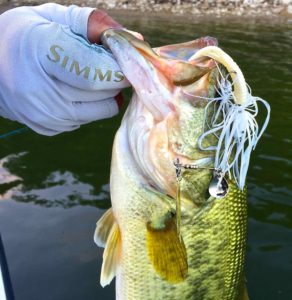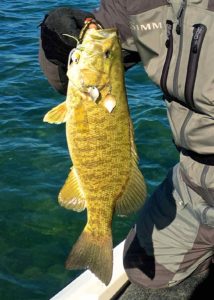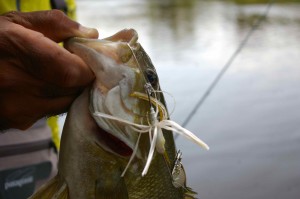Slow-Rolling Spinnerbaits for Summer Bass …
Slow-Rolling Spinnerbaits for Summer Bass …
Bernie Schultz – The Fishing Wire July 1st, 2021 …
At this time of year, many of the bass we are after are deep. They’re away from the shoreline relating to offshore features. And though today’s electronics can help us find them, catching them is a whole other matter.
Let’s assume we know where they are, their depth and the type of structure they’re holding on. What lures would you throw?
One that’s high on my list is a big spinnerbait — the kind specifically designed for fishing deep. I’m talking 3/4-ounce and heavier. The kind that get down quick and stay there throughout the retrieve. The kind that can also attract bass from a distance, or pull them out of heavy cover … even trick those that aren’t in the mood to feed.
Why a blade bait, you ask?
Spinnerbaits are relatively snag proof. They have the ability to pass through cover too gnarly for other moving lures — particularly crankbaits. And that makes them ideal for probing submerged brush, rockpiles and thick grass.
Spinnerbaits are also great baitfish imitators.
Whether it’s a cluster of small threadfin or large, single gizzard shad, the right blade size, colour and profile can fool bass into believing the lure is real. We’re talking willow-leaf blades, of course — either tandem or paired with a leading Colorado blade.
Willow-leaf blades are fish-shaped and they give off a tremendous amount of flash. Built with the right combination of components and head weight, they can maintain lateral movement while maximizing travel time through the strike zone. And that is precisely why slow-rolling a spinnerbait is so effective. The key is keeping the lure in frequent contact with the bottom or the cover related to it.
For instance, if you’re fishing the edge of a deep, submerged grassbed, you’ll want to be sure the lure stays in contact with the grass as it tapers off into deeper water. When the lure grabs the grass, rip it free and let it fall on a semi-slack line. At least until you feel the grass again. Then repeat. Strikes will usually occur as the lure is falling or when it regains forward motion.
The same applies to stumps, brush and rock. When the bait gets hung up, try ripping it free with a snatch of the rod tip. This sudden movement and flash mimics escaping prey and it can trigger a bass to strike.
The right setup:
To better facilitate these moves, it’s important to have the right balance of tackle.
Big spinnerbaits require heavier line with stout rods and reels.
My personal preference includes a rod in a medium-heavy action with moderate-fast tip. That length and action is ideal for casting big blade baits, as well as taking up slack on long distance hooksets. And I can feel every pulse of the lure as the blades turn. I pair it with their slower, 6.2:1 ratio reel, which allows me to retrieve the spinnerbait at the right rate of speed — assuring that it stays deep throughout the retrieve and telegraphs even the most subtle vibrations, so I know what the lure is doing at all times. And it has the guts to handle big baits and big bass in thick cover.
The line I spool it with depends on certain variables. If the water I’m fishing is super clear or the fish are line sensitive, I’ll go with 15- to 20-pound fluoro. If I want to “feather” the lure through the tops of submerged grass or brush, I may choose mono in the same pound rating for its buoyancy. In extra thick cover or if I know I’m on big bass, I’ll opt for Power Pro Super Slick braid — usually in the 30-pound class.
The business end:
Assuming you have the right balance of tackle, let’s discuss lure choice.
Most spinnerbaits used for this technique come with tandem blades, consisting of double willow or Colorado-willow combinations. That’s not to say that single spins won’t work, they will at times. But if you surveyed the top touring bass professionals, most would tell you they prefer a tandem model with a leading Colorado and trailing willow-leaf. The Colorado will provide much of the vibration, while the willow-leaf will better match the profile of live baitfish. Willows also provide maximum flash without forcing the lure to rise too much.
Spinnerbaits designed for slow rolling are usually bigger in all aspects — the blades, frame, head and hooks are all upsized. But it’s important that all of these components are balanced and working together … even the skirt and/or trailer can influence the lures overall performance.
Some anglers prefer super-sized trailing blades — No. 7 or 8 willow leafs. That’s fine if you’re after giant bass. But keep in mind, the larger the blade, the more resistance it will create, and the more likely the lure will “climb” during the retrieve. So, unless you have the patience of Job, I would suggest No. 5 or 6 willow-shaped blades. They turn easier, which can create more flash and vibration.
I generally prefer a No.4 front blade (either Colorado or willow) paired to a No.6 trailing willow leaf.
My spin on things:
When it comes to blade finishes, nickel-silver or gold are the two most common choices. Skirt patterns are normally white, chartreuse, or a blend of the two. If a soft-plastic trailer is added, its colouration usually matches one of these patterns. Obviously there are exceptions. But day in and day out, these are the most reliable combinations.
These are the tools I use when fishing a spinnerbait through deep structure. Hopefully what I’ve shared will help you next time you’re out on the water.
Follow Bernie Schultz through his website.
See here for other bass techniques.






